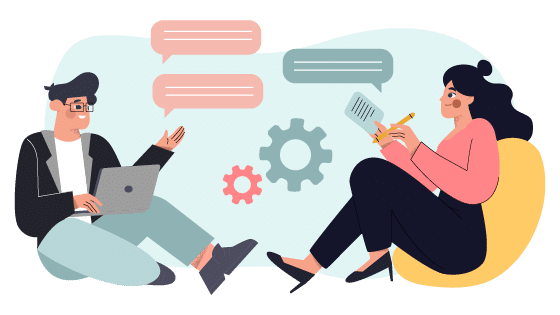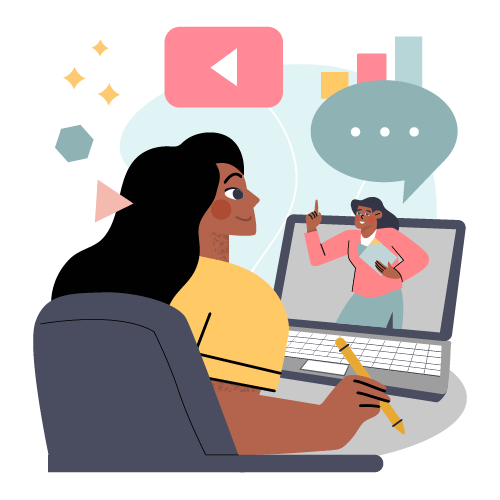Continuous learning is a golden key to personal growth. As we learn and develop our skill sets, we broaden our minds and open doors. Turning your education into a lifelong habit will ensure you are never stuck behind a closed door and you can easily unlock your full potential.
What is continuous learning?
Continuous, or lifelong, learning is the ongoing pursuit of knowledge. It is voluntary, self-motivated, and can take place in any form—from a degree to a documentary.
Cultivating a continuous learning culture within your organization will reap untold rewards in terms of employee engagement, employee retention, and productivity. People need to be stimulated to grow; otherwise, they stagnate and soon get bored.
So strong is the desire to learn that, in the recent past, 60% of the workforce set out to begin skills training independently from their employers. This reflects a desire for knowledge that is so strong that our employees will seek it for themselves if it is not provided for them. Our workforce’s urgent agenda to learn should move our focus to how best to facilitate opportunities to engage our employees in continuous learning. When they are so keen to learn, should we simply lecture them, or should we provide continuous active learning opportunities?
Continuous active learning engages the learner and requires them to participate in the learning process. This is proven to be an effective type of learning that encourages innovation within the workplace.
The benefits of continuous learning for individuals
What is continuous learning for individuals? It provides the opportunity to be intellectually stimulated and challenged on an ongoing basis. Why should all the fun of learning end when you enter the workplace? Now that there is the accessibility of eLearning, employees can work at their own pace, easily managing their learning schedule with their work time. Skills training facilitates better performance. Understanding and learning about the work they do provide job satisfaction.
How organizations benefit from a continuous learning culture
Higher employee engagement translates into higher productivity levels, which have a large impact on overall business success. If we can better engage our teams, we can improve our business outcomes. When asked, 92% of employees stated that well-planned training programs have a positive effect on their engagement levels at work.
Thanks to eLearning, we have technologies that facilitate time saving. For example, in adaptive learning, learners are only taught what they don’t know already. This means organizations can benefit from employee development using fewer time resources.
Employees are happier when working in a continuous learning culture. According to a study, employees that learn at work are less stressed (47%), feel more productive and successful (39%), are more ready to take on additional responsibility (23%), and are more likely to feel happy and confident (21%). And what’s even better is the more they learn, the happier they feel!

Why would organizations want a culture of continuous learning?
Continuous learning is so beneficial to an organization that they should want to develop it as part of their overall organizational culture. Adoption has been an issue in the past for many organizations, which must be addressed at a cultural level by focusing on the benefits. That can be the biggest hurdle in the initial implementation. But once continuous learning becomes an accepted part of your organizational culture, it becomes second nature. Once adopted by the organization, the improvements and better outcomes that stem from the new cultural element reiterate its importance on an ongoing basis.
Top talent and a continuous learning model
According to a recent study, individuals with high intelligence levels naturally prefer to engage in more demanding cognitive activities. The very definition of cognition is to acquire knowledge and learn. Therefore, in order to retain our top talent, we must facilitate opportunities for them to learn.
The talent market is tight, and providing ongoing education or having a continuous learning model in place is cited as an essential talent retention strategy. It makes talent feel valued and that they are an important part of the company’s success.
6 ways to cultivate a culture of continuous learning
1. Create a learning plan
A learning plan is a document that outlines the strategy and implementation of an organization’s employee learning initiatives. It sets clear objectives and defines processes in order to achieve these objectives. It gives direction and clarity. The plan you draft should suit your organization and its needs. Creating a learning plan is a great way to start on your journey to creating a culture of continuous learning.
2. Allocate resources and time to your continuous learning model
Set aside some time for planning and implementation. For cultural change to take effect, it requires some effort and resources. Create a budget and an internal marketing plan to obtain buy-in from your employees. Thanks to eLearning technology, your employees will be able to manage their own learning schedules.
3. Ensure availability of content
However you choose to run your continuous learning model, ensure it is widely accessible to your employees. This will ensure they gain maximum benefit from it and the optimal use of resources. They should be able to easily select what they want to learn. This way they will gain more from the experience and success rates will be higher.
4. Ensure content is relevant
Make sure your continuous learning model is relevant to your employees and their roles. If the content relates to their jobs, they will engage with it on a higher level, and the organization will benefit. Job-related skills development, knowledge, and learning will all contribute to higher performance levels in their roles.
5. Provide user-friendly training
Ensure that employees feel comfortable and can easily navigate your chosen continuous learning model—eLearning is an excellent option for flexibility and accessibility. If accessing content is challenging, adoption into the culture will be slower.
6. Encourage microlearning
Microlearning is delivering learning content in small learning units. It’s really great for skills training if time is limited or to spark interest. It’s less demanding for busy schedules, so it is a great way to encourage adoption.
Continuous learning examples
There are many ways you can engage in continuous learning. There are formal options like an eLearning course, workshops, or an after-hours, short course at a college. You can find the opportunity through an employer, government program, or on your own. Then there are informal options like educating yourself through reading, podcasts, or educational television. One can even learn on social media or by starting a blog!
Everybody benefits from a continuous learning culture
When it comes to continuous learning, both employees and employers benefit enormously. Employees enjoy their jobs more, which affects their entire lives. They feel valued and as if they are contributing. They are more innovative and engaged and, therefore, more productive. Organizations benefit from those higher productivity levels and are better off financially. They spend less time and money on hiring and retention strategies.
Benjamin Franklin said “Tell me and I forget, teach me and I remember, involve me and I learn.” Let’s work towards providing continuous active learning opportunities and creating a culture of continuous learning within our organizations, thereby ensuring we thrive now and into the future.






